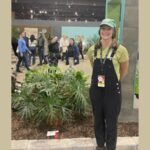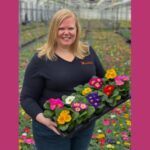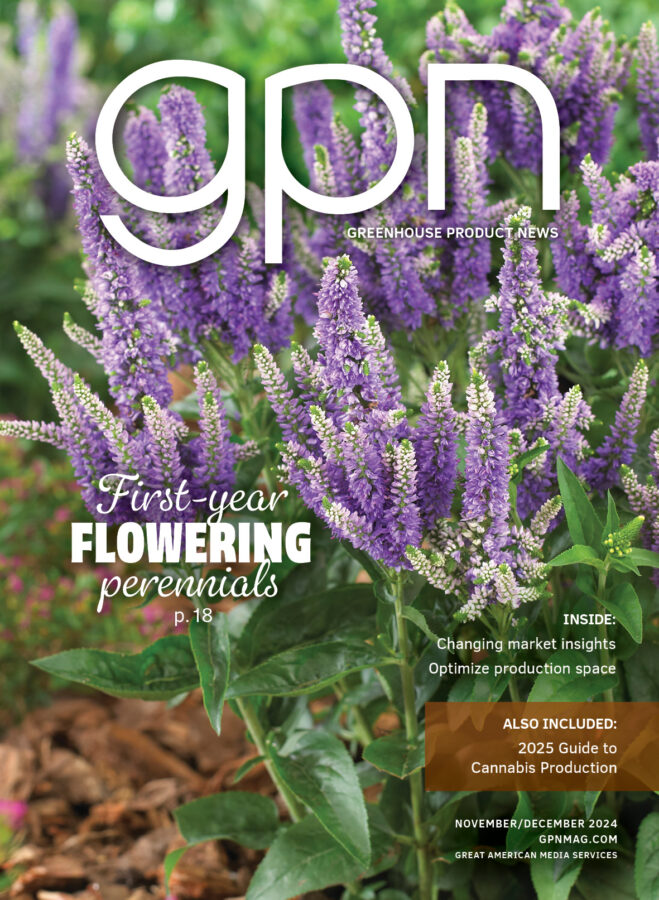
Emergence of Rooftop Production
In the United States, as well as worldwide, green roofs have become vital components of new construction on a broad variety of buildings, from municipal to commercial and industrial to residential. In its simplest form, a green roof may contain a sampling of sedums or other hardy succulents; whereas, many modern green roofs have increased the diversity of plants being grown by installing deeper growing medium and changing the way green roofs are used.
Green roofs provide a number of economic and environmental benefits such as reducing energy costs, reducing the urban heat- island effect, managing storm water runoff and creating habitats for wildlife. But more often, green roofs are being developed as pleasure places, urban sanctuaries and for growing food crops. Ultimately, the success of a green roof is due to the success of the plants growing on it. Plant trials, like the one undertaken at the Chicago Botanic Garden, are crucial to increasing knowledge and awareness of the best plants for green roof culture.

The Study
In September 2009, we opened our Plant Conservation Science Center, which includes a 16,000-square-foot green roof for trialing and displaying herbaceous and woody plants. The green roof is divided into two 8,000-square-foot gardens, located on each side of the building’s central clerestory. The north green roof features nonnative and native plants in a gardenlike design.
Conversely, North American native plants inhabit the naturalistic south green roof, which resembles a prairie or meadow landscape. Each of the green roofs is divided into display and evaluation areas, which are further divided into beds with 4, 6 and 8 inches of growing medium. At these growing depths, the green roof is within the extensive to semi-intensive range, which allows for a greater diversity of plants than would be possible in the shallow 4-inch depth. The growing medium is a mixture of expanded clay and shale, vermiculite, perlite, sand and organic matter.
Our evaluation study began in the spring of 2010 with the primary goal of developing an extensive list of recommended plants for green roofs. Greater biodiversity supports the aesthetic design of green roofs as well as creates habitats for a variety of beneficial pollinators and wildlife. The 216 taxa in the trial were selected for their potential to succeed in the temperature and moisture extremes typical on a green roof in Zone 5. While some of the varieties had been grown on green roofs elsewhere, a portion of them were new or uncommon on green roofs.
All plants were evaluated for their cultural adaptability to the growing medium and environmental conditions; disease and pest problems; winter hardiness or survivability; and ornamental qualities associated with flowers, foliage and plant habit. In addition, plants were monitored for reseeding and weediness. Final performance ratings were based on plant health and vigor, survivability and longevity, habit quality and flower production and winter hardiness during the evaluation period. By the end of the trial in 2015, 14 percent of the original 216 taxa had died.
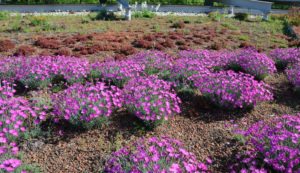
Evaluation Results
In the five-year trial, 78 of the 216 taxa received top ratings for their strong performances. Nine received five-star excellent ratings for their overall performance (good vigor and robust habits, superior ornamental qualities, disease resistance, heat and drought tolerance and winter survivability), including Antennaria dioica, Calamintha nepeta ssp. nepeta, Juniperus chinensis var. sargentii ‘Viridis’, Phlox subulata ‘Apple Blossom’, Phlox subulata ‘Emerald Snow’, Phlox subulata ‘Snowflake’, Rhus aromatica ‘Gro-Low’, Sporobolus heterolepis, and Sporobolus heterolepis ‘Tara’. Additionally, 69 taxa received four-star good ratings.
As in a typical garden, plants were assessed for their floral traits — color, size, bloom period and flower production. Many had exceptional floral displays, which enhanced the ornamental aspect of the green roof from spring to fall. Early bloomers such as Viola sagittata, Antennaria dioica, Geum triflorum, Dianthus gratianopolitanus ‘Firewitch’, Phlox bifida, Tetraneuris herbacea, Tradescantia tharpii and Phlox subulata brought the green roof to life beginning in late April. Summer-flowering perennials provided the longest bloom periods, from June through August; among the best floral shows were Amorpha canescens, Agastache foeniculum, Bouteloua curtipendula, Calamintha nepeta ssp. nepeta, Coreopsis lanceolata, Dalea candida, D. purpurea, D. villosa, Penstemon digitalis, P. hirsutus and P. hirsutus ‘Pygmaeus’. A variety of grasses added greatly to the late season show along with perennials such as Helianthus mollis, Hosta lancifolia, Hylotelephium ‘Rosy Glow’, Lespedeza capitata, Liatris ligulistylis, Salvia azurea var. grandiflora, Solidago rigida and Solidago ‘Wichita Mountains’.
A plant’s habit determines its usefulness, whether planted in mass, intermixed with other plants or as an accent. Consistently strong bushy habits — for massing or intermixing — were observed on Amorpha canescens, Andropogon gerardii, Calamintha nepeta ssp. nepeta, Coreopsis lanceolata, Dalea candida, D. purpurea, D. villosa, Dianthus gratianopolitanus ‘Firewitch’, Festuca amethystina ‘Superba’, Galium verum, Heuchera richardsonii, Hosta lancifolia, Juniperus chinensis var. sargentii ‘Viridis’, J. hortizonalis ‘Wiltonii’, Koeleria glauca, K. macrantha, Nepeta racemosa ‘Walker’s Low’, Penstemon digitalis, P. hirsutus, P. hirsutus ‘Pygmaeus’, Phlox bifida, P. subulata ‘Apple Blossom’, P. subulata ‘Emerald Blue’, S. subulata ‘Snowflake’, Rhus aromatica ‘Gro-Low’, Schizachyrium scoparium, S. ‘Wichita Mountains’, Sporobolus heterolepis and S. heterolepis ‘Tara’. Taxa with the strongest matlike habits for use as groundcovers, included Antennaria dioica, Potentilla neumanniana, Sedum hybridum ‘Immergrünchen’, S. kamtschaticum ‘Variegatum’ and S. spurium ‘John Creech’. Buchloe dactyloides ‘Legacy’ was an effective groundcover, but its dense habit smothered other plants as it spread widely.
A number of plants spread by vegetative means but none proved to be too aggressive. On the other hand, spreading by seed was a common and sometimes troublesome occurrence. The most vigorously reseeding taxa included Artemisia caudata, Calamagrostis brachytricha, Helianthus mollis, Hieraceum spilophaeum ‘Leopard’, Koeleria glauca, K. macrantha, Oligoneuron album, Rudbeckia hirta and Talinum calycinum. By all measures, Chamaecrista fasciculata (formerly Cassia fasciculata) was the most prolific reseeder, dropping so much seed that the resulting seedlings formed an impenetrable mass that filled all nearby open ground and enveloped other plants.
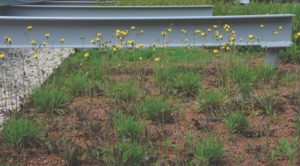
Environmental Conditions
Plants were regularly monitored to see how well they survived and thrived in the environmental conditions on the green roof. Together or alone, heat and drought resulted in weakened plant health, partial vegetative loss, premature dormancy and/ or death. At the outset of the trial it was decided that irrigation after establishment would be restricted unless necessary to ensure the survival of the plantings. The green roofs were irrigated three times between 2010 and 2014 during periods of extreme heat and drought. While not all plants were able to overcome these cultural challenges, most plants rebounded well following rain or irrigation.
All plants were impacted by drought in varying degrees at some time each summer, but plantsgrowing in 4 inches generally showed signs of heat- and drought-stress first. Regardless of growing depth, Geum triflorum was the best indicator plant for drought, always being the first to show signs of stress. We irrigated before drought became severe enough for Geum triflorum to go dormant or for significant plant losses to occur; health and vigor improved quickly once the droughty period was over. Aquilegia canadensis went dormant in the hottest periods, and Viola sagittata stalled during droughty periods but rebloomed once moisture was available. Andropogon gerardii and Bouteloua curtipendula seemed adaptable to dry conditions, but most of their lower leaves turned brown; Bouteloua curtipendula in four inches generally lacked vigor and some plant losses were noted in droughty periods. Conversely, Koeleria macrantha, Sporobolus heterolepis and S. heterolepis ‘Tara’ off-colored the least during unfavorable conditions; however, Sporobolus heterolepis and ‘Tara’ showed earlier fall color following droughty periods.
The trial began with the assessment of plant losses during the first winter of 2009-10. Approximately 25 percent of the original plantings died during that winter. In subsequent years, winter losses were never as great, and were commonly associated with weakened plant health due to environmental causes such as drought rather than simply cold hardiness. In addition, frost heaving and winter-desiccation were consistent problems for some plants, such as Armeria maritima ‘Alba’, A. maritima ‘Rubrifolia’, Aster oharai, Erigeron caespitosa, E. scopulinus, Penstemon grandiflorus and P. grandiflorus ‘Prairie Snow’. In some years, Heuchera richardsonii and H. micrantha ‘Palace Purple’ were affected to a lesser degree.
With increased development and reimagination of green roofs and their uses, the need for a greater variety of plants that will successfully grow on green roofs is critical. Given this need, our green roof study was not a one-time event — new plants will continually enter the trial in coming years. Over time and with continued trialing across geographic regions, our results will be a part of a compendium of the best plants for green roofs.


 Video Library
Video Library 













